Samsung UE55ES8000 Review
Samsung UE55ES8000
Exclusive: The Samsung UE55ES8000 is the company's new flagship TV and as expected it is, for the most part, nothing short of spectacular.
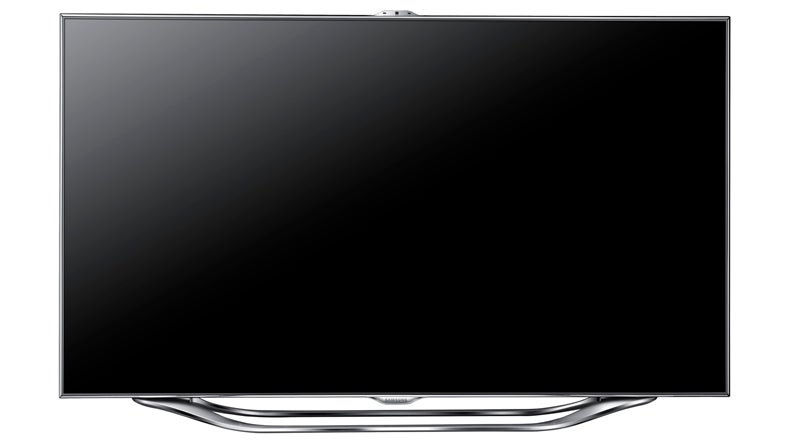
Verdict
Pros
- Stunning design
- phenomenal feature count
- Excellent 3D and 2D performance
Cons
- The gesture control system is currently unhelpful
- Occasional backlight bleed, especially with 3D
Key Specifications
- Review Price: £2499.00
- 55in LCD TV with edge LED lighting
- Active 3D playback
- New Smart TV platform
- Built-in camera
- Voice and gesture control systems
Part of us has been giddy with excitement about the arrival of Samsung’s new flagship TV on our testbenches, but part of us has also been dreading it. For while some of the stuff the 55in UE55ES8000 is capable of really captured our imagination when we saw it in action at the recent CES in Las Vegas, the thought of the sheer amount of time we’d need to explore every nook and cranny of these new features was frankly intimidating.
Happily the majority of the ‘legwork’ part of the UE55ES8000 reviewing process is now behind us, leaving us free to just focus on feeling excited by it. And if anything, our excitement levels are even higher now we’ve spent a few days with the TV than they were before we got it.
The UE55ES8000 sets your pulse racing from the off thanks to its stunningly thin chrome-like bezel, and cool ‘bulges’ at the centre of its top and bottom edges containing a built-in camera and cutely illuminated Samsung logo respectively.
We guess you could argue that the UE55ES8000 doesn’t really advance the cause of TV styling all that much from Samsung’s 2011 range. But frankly, it doesn’t need to. Seeing 55in of screen clad in so little bodywork is a trick that never gets old.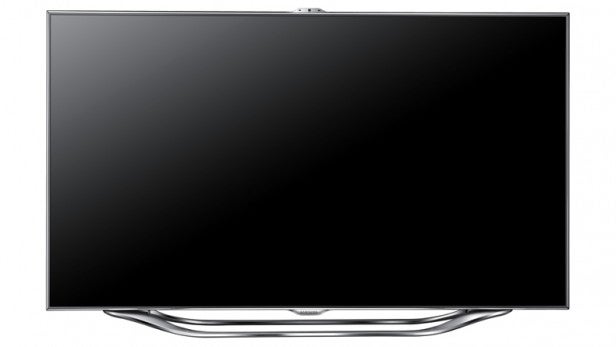
The UE55ES8000’s connectivity is predictably expansive. HD and 3D sources can be piped in via any of four side-mounted HDMIs, while the set’s massive multimedia potential is unlocked via a pair of USBs, a D-Sub PC port, a LAN port, and built-in wi-fi.
The USBs are able to play a wide array of video, photo and music files, with the same files also playable via a connected, DLNA-ready PC. The USBs can also be used, as you would expect with a modern flagship TV, to record from the integrated Freeview HD tuner.
The real core of the UE55ES8000’s multimedia experience, though, comes via its Wi-Fi/LAN connections. For it’s through these that you can delve into the latest version of Samsung’s Smart TV online platform.
The improvements Samsung has wrought here are obvious as soon as you hit the cool new colourful ‘Smart Hub’ button on either of the two remotes you get with the UE55ES8000 (more on these later). First, the graphics used for the icons on the screen look much more attractive and ‘HD’ – a result of them using a full HD 1080 resolution rather than the previous 720-line mode.
Second, while the general layout is broadly the same as last year’s, the central row of icons has been enlarged and now contains a trio of key new services: Family Story, Fitness and Kids.
Probably the single most innovative of these is the Family Story. This enables you to set up a ‘private’, pin-protected network with other Smart TV, Smart device or PC users of your choice – likely family members – for easy sharing of photos, calendars and memos. It’s a bit faffy to set up and at the time of writing it’s usefulness is currently limited by the fact that the PC and Smart device apps for the service aren’t live yet, while our test sample is pretty much the only ES8000 sample in the UK until the range officially launches towards the end of February! But the potential of the feature is clearly huge; it even caught the imagination of this writer’s mum, for heaven’s sake, and there isn’t much technology that does that!
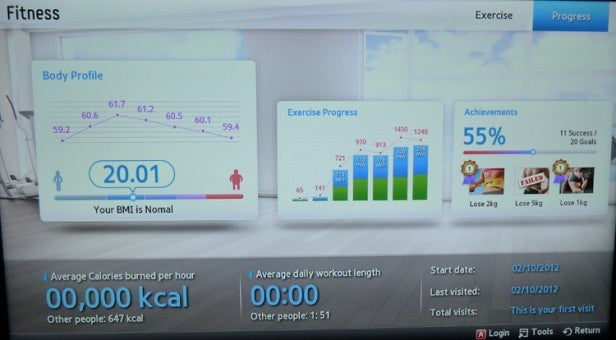
The Fitness section is essentially an aggregation of fitness-related apps available on Samsung’s Smart TV system. However, it goes further than that by letting you to set up user profiles to which the provided activities can be attached.
This is a great touch, of course, because it allows you to follow your progress and have the TV provide you with a readily visible, automatically updated record of your fitness activities. Charted are your BMI measurements, your exercise progress in minutes and calories, and your ‘achievements’, which are chiefly based around weight loss goals. The system handily tells you how many calories you need to burn to produce a certain weight loss for your body mass, while the exercise apps consist of videos of exercise regimes for you to follow, with the number of calories each exercise ‘clip’ will burn displayed next to its title.
All this information is all very nicely presented, and really gives you that sense of almost hour by hour progress that’s so key to a successful fitness or weight loss regime.
Obviously there’s no way of recording your food intake on the Fitness system, so it’s not a total weight loss/fitness solution. But it goes further than expected, all the same.
The Kids section of the latest Smart Hub is a little less meaty than the other two, comprising a (currently smallish) selection of videos from the Canimals Animation series, and a rather more useful sticker book, into which parents can add ‘well done’ stickers to reward their childrens’ behaviour.
The presentation of this area is suitably child-friendly, and our own children certainly seemed to enjoy the challenge of earning stickers for the ‘cool’ onscreen book. This area definitely needs more content and activities before it really becomes exciting, but the core ideas seem solid enough.
Joining these major newcomers to the Samsung Smart TV scene is a long – arguably bewildering – list of other video streaming and utlility/game/info apps. The video streaming apps now include, we’re pleased to note, Netflix, which joins the more established likes of Dailymotion, MUZU.TV, AceTrax, the Cartoon Network, Vimeo, YouTube, PictureBox, Explore 3D, Boxoffice 365, LoveFilm and, of course, the BBC iPlayer.
Among the non-video apps to catch our eye are an open Web browser, Skype (which is bolstered by the startling quality of the built-in camera), Facebook, Twitter, Picasa and Google Maps. In total there are currently around 195 apps, not including the Fitness video routines, catering for pretty much every taste and eccentricity.
We still feel many of these lesser apps are of very limited interest/usefulness, but the latest interface does a better job of presenting them so that they don’t feel as much like ‘unnecessary clutter’ as they did on last year’s Samsung Smart TVs.
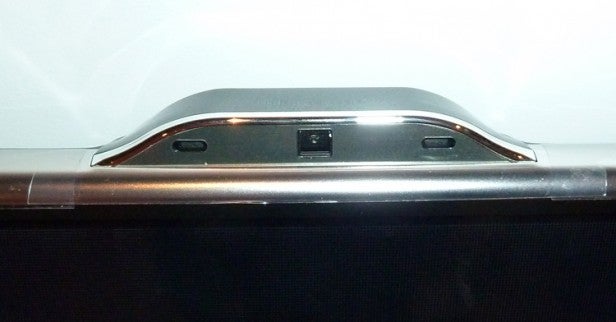
One problem with Smart TV platforms is that some of their features don’t lend themselves to normal TV interfaces. But Samsung’s tried to address this problem too, by introducing a radical new combination of control systems. So extensive and illustrative of the way the industry is shifting are some of these control systems that we’re going to cover them in depth in a separate review in the next day or so. But to give you the basic idea, the UE55ES8000 a) comes with both a normal remote and a second, ‘trackpad’-style remote; b) can respond to a remarkably wide variety of voice commands; and c) can be controlled via the movements of your hand.
For a brief summary of our findings ahead of the more in-depth article, after initial resistance we eventually found ourselves thoroughly seduced by the startling flexibility of the voice control system; we were very impressed by the touchpad remote; but we were thoroughly uninspired by the gesture control approach (though see my comment below). But heck – two out of three ain’t bad. Especially when those two are enough to deliver the first fully integrated, truly ‘next generation’ control system we’ve experienced to date.
While all the Smart TV innovations are fun and exciting, though, it’s with the UE55ES8000’s picture improvements that it really begs for your attention.
The single biggest deal here is the introduction of a dual-core processor, which enables the TV to handle far more picture processing tools in real time than was possible before. Particularly significant is the way Samsung has doubled the number of picture ‘blocks’ analysed by its latest micro dimming system to an extremely healthy 576, to deliver much more accurate and effective lighting of each frame of the image.
Samsung has also done a lot of work to improve its 3D performance, with faster panel driving and crosstalk reduction routines now in play. The boost in processing power also means that you can now apply Samsung’s motion processing to 3D playback as well as 2D – something that has a surprisingly positive impact, as we’ll see soon.
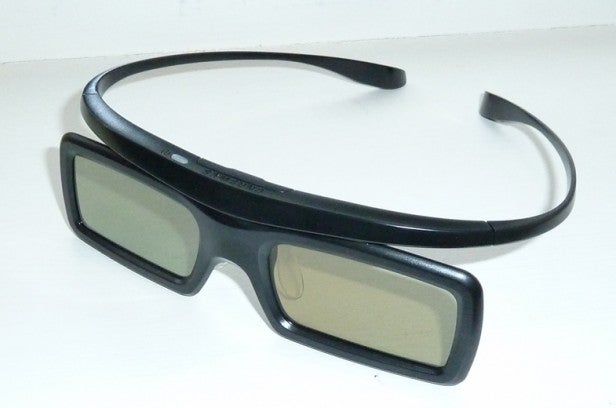
Intriguingly, the UE55ES8000’s specification isn’t necessarily limited to what’s currently ‘under the hood’. For the set has actually been designed to be upgradable in the future, by ‘slotting in’ next-gen chipsets – including, potentially, a quad-core processor. This could greatly enhance the longevity of the UE55ES8000 – so long as Samsung actually produces the upgrade ‘kits’, of course!
Finally settling down to just watch what the UE55ES8000 can do, its pictures immediately look nothing short of spectacular. We’ve often found previous Samsung LED picture generations to look extremely vibrant and dynamic, but – presumably thanks to the much-improved micro dimming system – things are taken to a whole new level here. Especially, crucially, when watching dark scenes, as the set is able to combine deep blacks simultaneously with much purer, brighter whites and colours than any previous Samsung edge LED TV. In fact, we can’t think of any other edge LED TV full stop that can combine light and dark content as successfully as the UE55ES8000.
Making this all the more impressive is the fact that dark areas of the picture also contain plenty of shadow detail, showing that the screen isn’t just ‘crushing’ dark areas to produce its convincing black colours.
Sticking with the screen’s excellent contrast performance for LED technology, we were also generally impressed with how little the screen suffers with the dreaded backlight inconsistency problem that so troubled some users of Samsung’s 2011 screens. Or at least this is the case if you’re careful with how you calibrate the UE55ES8000’s images. Certainly the backlight should not be left any higher its 9 level for 2D viewing, and actually we’d recommend 7 or even 6 if you’re watching in a dark room. With this in mind though, we found 2D moments where we felt even slightly troubled by backlight inconsistencies to be few and far between.
Colours, meanwhile, are outstanding. For a start they enjoy the most natural and wide tonal range yet seen from a Samsung TV – another result, we suspect, of the more localised picture ‘scrutiny’ made possible by the Dual-Core processor. Colours are also effortlessly subtle and expressive when it comes to showing miniscule tonal differences – something that’s particularly evident in the extremely natural look of skin tones.
Yet more good news concerns the UE55ES8000’s sharpness. HD images look phenomenally detailed, crisp and replete with texture. Indeed, it’s hard to think of any other brand other than, perhaps, Philips that’s able to deliver such an emphatic sense of the ‘HD advantage’.
Not that the UE55ES8000 only likes an HD diet, mind you. It’s also one of the best 55in standard definition upscalers we’ve seen, managing to add sharpness and detail to the image while simultaneously suppressing noise and retaining colour integrity. Even notoriously poor-quality standard-def channels like Investigation on Sky manage to look genuinely enjoyable.
Contributing to the image’s sharpness is the screen’s excellent motion handling. There’s less blur than there was on last year’s Samsung screens, which by default means there’s also less of it than on the vast majority of LCD TVs generally. Even better, the extra processing power available to the UE55ES8000 means that Samsung’s motion processing systems are much more effective than they ever have been before, proving able to reduce blur and judder without causing nearly as many unwanted side effects as has previously been the case.
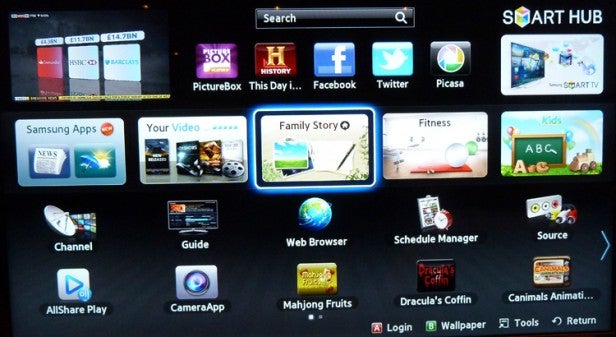
Certainly we found ourselves using the set’s MotionPlus system (albeit only on its relatively low-power Clear setting) much more than we ever have before.
We actually found MotionPlus particularly effective when watching 3D, now that the high-powered processing has made this possible. Having less judder in the image makes 3D viewing notably less tiring, as well as making the full HD advantage of the UE55ES8000’s active 3D system more instantly obvious.
It’s not actually the motion handling that’s the star attraction of the UE55ES8000’s 3D pictures, though. In fact, that honour could belong to any of three other 3D attributes.
First, crosstalk is massively reduced from Samsung’s 2011 3D TVs. In fact, it’s almost completely gone, generally only cropping up over very distant and very bright objects.
The impact this has on the UE55ES8000’s 3D pictures can’t be overstated, as it allows you to appreciate much more clearly the outstanding amounts of detail and sharpness in full HD pictures from 3D Blu-rays. With everything from Tangled to Avatar and Thor we saw details in the picture that we honestly hadn’t felt aware of before.
Also contributing to the amount of detail in the 3D image is their outstanding brightness and colour vibrancy. Putting on one of the two pairs of free, stylish – and light – 3D glasses results in much less of a reduction in brightness than we usually see with active 3D technology, enabling 3D images to deliver almost as much snap and punch as 2D images can. The fact that Samsung has been able to achieve this without compromising on crosstalk is pretty remarkable based on our previous experience with active 3D screens.
Aside from there still being room for a marginal further improvement where crosstalk is concerned, the UE55ES8000’s 3D pictures only suffer one real irritation. Which is that while watching dark scenes, the high brightness level the screen employs when in 3D mode causes quite obvious jets of light to appear in all four corners of the screen.
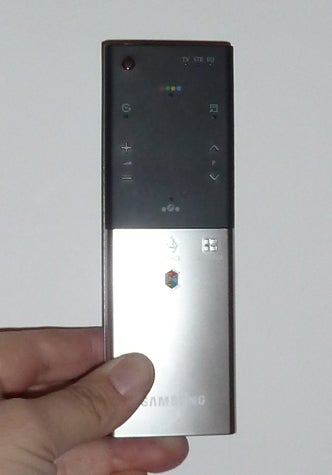
You can reduce the backlight level if you wish, just as you do to remove such consistency problems during 2D viewing. But of course, brightness is more important to the 3D picture on account of the active shutter glasses, so knocking down the backlight level feels like more of a sacrifice than it does in 2D mode. (see my comment below for an update on this issue)
We were also a little troubled by how exposed the new Samsung glasses are to light interference from either side of your head. This is easily avoided if you watch in the dark, though – and it’s been suggested to us that there may be a tweaked design of the glasses in the offing.
The last thing we tested on the UE55ES8000 was its input lag. And while we were satisfied as console gamers with the 38-40ms figure we measured during the majority of our tests, we were a little surprised to also register an occasional measurement of nearer 70ms. Since we had the screen in its Game mode (a mode that’s still bizarrely hidden within the ‘General’ section of the ‘System’ menu) and had all the screen’s processing turned off when we performed this test, it’s unclear where these occasional lag ‘spikes’ might be coming from. Samsung is investigating, and if they come up with anything interesting, we’ll let you know.
Let’s not let any of these negatives leave a sour taste in the mouth, though. The bottom line here is that with all the evidence duly weighed and considered, the UE55ES8000’s pictures – at least once you’ve calibrated them away from the often rather over-aggressive presets – can overall be considered outstanding, regardless of whether you’re watching 2D or 3D.
Sonically the UE55ES8000 is the best sounding ultra-thin TV Samsung has made. This does not mean, it must be said, that the UE55ES8000’s audio is particularly brilliant; it’s certainly very limited in terms of the volume levels it can attain. But there’s a decent sense of clarity and a pleasantly rounded tone that suffers noticeably less with shrillness and muddiness than last year’s ultra-thin Samsung screens.
Verdict
The UE55ES8000 marries ‘impossibly’ lovely looks with more ground-breaking features than we’ve arguably ever seen on a single TV before. And then it chucks in some superlative 2D and 3D picture quality for good measure.
In doing all this it delivers a much bigger leap forward from last year’s Samsung models than we’d expected, as well as setting the bar intimidatingly high for the rest of the 2012 TV jetset.
How we test televisions
We test every TV we review thoroughly over an extended period of time. We use industry standard tests to compare features properly. We’ll always tell you what we find. We never, ever, accept money to review a product.
Trusted Score
Score in detail
-
Features 10
-
3D Quality 9
-
Value 8
-
Design 10
-
2D Quality 9
-
Sound Quality 7
Features
| Size (Inch) | 55in |
| Display Type | LED |
| Max. Resolution | 1920 x 1080 |
| Full HD 1080p | Yes |
| Digital Tuner | Yes |
| Freeview HD | Yes |
| 3D Ready | Yes |
Connectivity
| HDMI | 4 (v1.4) |
| Component | 1 |
| Composite | 1 |
| Scart | 1 (RGB) |
| Digital Audio Out | 1 |
| Headphone | 1 |
| Charging/Computer Connection | 2 |
| Ethernet | Yes |
| WiFi | Yes (built-in) |
Physical Specifications
| Height (Millimeter) | 722.3mm |
| Width (Millimeter) | 1230.3mm |
| Depth (Millimeter) | 30.8mm |
| Weight (Gram) | 16.6g |

